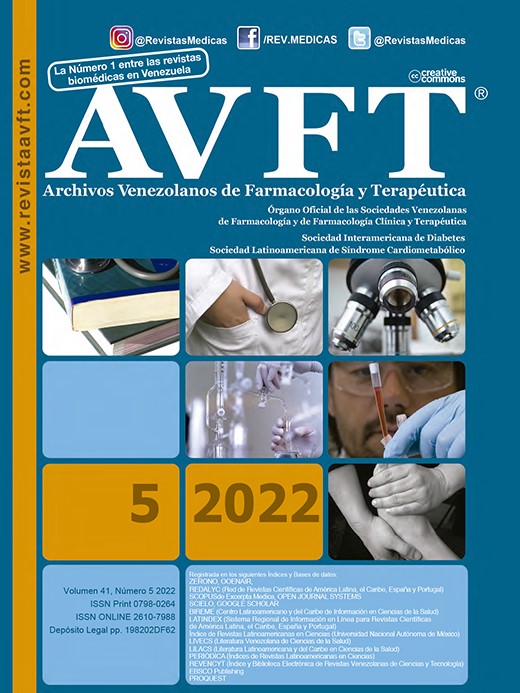Behavior of food habits in students of an educational institution of Barranquilla-Colombia
Keywords:
Nutrition; Health; Eating habits; StudentsAbstract
Introduction: Eating habits have a significant impact on human health, hence the importance of knowing them in order to identify risk factors that can trigger diseases related to inadequate nutrition. Objective: to identify the behavior of eating habits in students of an educational institution in Barranquilla-Colombia. Methods: quantitative, descriptive and cross-sectional study. The sample corresponded to 426 students from an educational institution with an average age of 14-16 years. Food consumption is determined through a structured and self-administered questionnaire in which eating habits were analyzed. Results: 55% of the participants were female, and 45% male. Most belong to socioeconomic strata 1 and 2. In relation to eating habits, the results of the study are inadequate, mainly in relation to the frequency of their consumption and unhealthy aggregates. The students responded that they always eat breakfast, have never brought a lunch box to school, eat salty and high-fat food at least once a day. The consumption of fruits and vegetables is done infrequently. Conclusion: Adequate eating habits represent at an early age a good beginning for the development of the person and their future in terms of their health. In the population studied, there is an inappropriate behavior of eating habits due to access to them due to their costs as well as evidence of the need for education towards healthier alternatives.
Downloads
References
Castillo V., Escalona J., Rodríguez C. Hábitos alimentarios en la población escolar chilena: Análisis comparativo por tipo de establecimiento educacional. Rev. Chil. Nutr. 2016 marzo; 43(1):06-11. Disponible en: http://dx.doi.org/10.4067/S0717-75182016000100001
Mundial de Organización Salud (OMS), Dieta, Nutrición y Prevención de Enfermedades Crónicas. Disponible en: http://www.fao.org/3/ac911s/ac911s00.pdf
Encuesta Nacional de la Situación Nutricional en Colombia 2010, Disponible en: https://www.minsalud.gov.co/sites/rid/Lists/BibliotecaDigital/RIDE/VS/ED/GCFI/Base%20de%20datos%20ENSIN%20-%20Protocolo%20Ensin%202010.pdf
Barragán L., Alarcón A. Estilos de vida saludables en personal docente, administrativo y de apoyo de la escuela de enfermería de la Universidad de Guayaquil 2015.Repositorio uniguayaquil. 2015. Disponible en: http://repositorio.ug.edu.ec/bitstream/redug/8196/1/PROYECTO%20DE%20INVESTIGACI%C3%93N%20ESTILOS%20DE%20VIDA%20SALUDABLES.pdf
Cigarroa I., Sarqui C., Zapata Lamana R., Efectos del sedentarismo y obesidad en el desarrollo psicomotor en niños y niñas: Una revisión de la actualidad latinoamericana. Rev Univ. Salud. 2016; 18(1):156-169. Disponible en: https://www.researchgate.net/profile/Igor_Cigarroa/publication/309601231_Efectos_del_sedentarismo_y_obesidad_en_el_desarrollo_psicomotor_en_ninos_y_ninas_Una_revision_de_la_actualidad_latinoamericana/links/5840544f08ae61f75dcee10b.pdf
Ministerio de Salud y Protección Social. Colombia (ENSIN) 2015.2015. Disponible en. https://www.minsalud.gov.co/Paginas/Barranquilla-recibio-resultados-de-Encuesta-Nacional-de-Situacion-Nutricional-de-Colombia-ENSIN-2015.aspx
Instrumento STEPS, El método STEPwise de la OMS para la vigilancia de los factores de riesgo de las enfermedades crónicas Organización Mundial de la Salud Avenue Appia, 1211 Geneva 27, Switzerland. Disponible en: www.who.int/chp/steps
Ministerio de Salud. Resolución número 008430 de 1993. Disponible en: https://www.minsalud.gov.co/sites/rid/Lists/BibliotecaDigital/RIDE/DE/DIJ/RESOLUCION-8430-DE-1993.PDF
Roberth Olmedo R, Domínguez J, Macías A. Hábitos alimenticios en estudiantes de la carrera de enfermería. Rev. de Salud VIVE.2019; 2(5): 92-98. Disponible en: http://revistavive.org/index.php/revistavive/article/view/29/116
Campo L, Herazo Y, García F, Suarez M, Méndez O, Vázquez F. Estilos de vida Saludables de niños, niñas y adolescentes. Rev. Científica Salud Uninorte. 2017; 33(3):419-428. Disponible en: http://rcientificas.uninorte.edu.co/index.php/salud/article/viewArticle/8767/214421442428
Duarte C. Factores relacionados con las prácticas alimentarias de estudiantes de tres universidades de Bogotá. Revista de Salud Pública 2015; 17(6). DOI: http://dx.doi.org/10.15446/rsap.v17n6.38368
Aulestia-Guerrero E, Capa-MoraU E. Una mirada hacia la inseguridad alimentaria sudamericana. Ciênc. saúde coletiva. 2020. 25(7). DOI: https://doi.org/10.1590/1413-81232020257.27622018
Sánchez Bizama J, Oda-Montecinos C, Cova Solar F, Hemmelmann Fuentes K, Betancourt Peters I, Beyle Sandoval C. Estilos de ingesta de estudiantes universitarios chilenos: ¿qué hay de nuevo? Nutr Hosp 2020;37(4):807-813. DOI: http://dx.doi.org/10.20960/nh.02656
Morales R., Lastre G., Vásquez A. Estilos de vida relacionados con factores de riesgo cardiovascular. Repositorio Universidad Simón Bolívar .2018; 2018 37(2)12-16 Disponible en:http://www.revistaavft.com/images/revistas/2018/avft_2_2018/11_estilos_de_vida_relacionados.pdf
Ceriani- Infantozzi F,De León- Giordano C. Características que se asocian con la omisión del desayuno en adolescentes montevideanos que concurren a colegios privados. Rev. Enfermería: cuidados humanizados. 2017; 6(2): 4-19.DOI: http://dx.doi.org/10.22235/ech.v6i2.1461.
Tuero, C. C., Zagalaz, J. C., Sánchez, M. L. Z., & de Mesa, C. G. G. Conocimientos e intereses sobre hábitos alimentarios saludables y práctica de actividad física. Un estudio con población adolescente. Aula abierta.2018. 47(2), 211-220.Disponible en: 10.17811/rifie.47.2.2018.211-220
Ávila M., Gutiérrez G., Martínez L., Ruíz J., Guerra J., Comportamiento e hábitos alimentares en alumnos do ensino básico. Horiz. Sanitario. 2018; 17(3): 217-225. Disponible en: http://dx.doi.org/10.19136/hs.a17n3.2113.
Muñiz-Mendoza P, Cabrera-Pivaral C, Orozco-Valerio M, Báez-Báez L, Méndez-Magaña A. Hábitos e ingesta alimentaria de frutas y verduras en estudiantes de educación superior. Rev. Chil. Nutr. 2018; 45(3): 258-262. DOI: http://dx.doi.org/10.4067/s0717-75182018000400258
Vera V, Crovetto M, Valladares M, Oñate G, Fernández M, Espinoza V, Mena F, Durán S. Consumo de frutas, verduras y legumbres en universitarios chilenos. Rev. Chil. Nutr. 2019; 46(4): 436-442. DOI: http://dx.doi.org/10.4067/S0717-75182019000400436.
Pampillo T., Arteche N., Méndez M., Hábitos alimentarios, obesidad y sobrepeso en adolescentes de un centro escolar mixto. Rev. Ciencias Médicas. 2019; 23(1): 99-107. Disponible en: http://scielo.sld.cu/scielo.php?script=sci_arttext&pid=S1561-31942019000100099&lng=es.
OMS. Obesidad Infantil: preguntas frecuentes. 2017. Disponible en:https://www.who.int/end-childhood-obesity/faq/es/
Tamames S. Implicaciones sociales y sanitarias de la obesidad mórbida. Rev. An RANM. 2019; 136 (02): 108 a 112. DOI: 10.32440/ar.2019.136.02.rev03
Médicos y pacientes. 2020. Disponible en: http://www.medicosypacientes.com/articulo/la-oms-avisa-de-que-el-consumo-de-grasas-trans-provoca-unas-500000-muertes-al-ano-en-todo
Downloads
Published
How to Cite
Issue
Section
License
Copyright (c) 2023 AVFT – Archivos Venezolanos de Farmacología y Terapéutica

This work is licensed under a Creative Commons Attribution-NonCommercial-NoDerivatives 4.0 International License.




